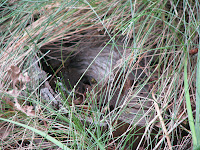 |
| Nest entrance (lower center) at base of tree. |
 |
| Yellowjacket wasps guard entrance to nest. |
Between mid-summer and early fall yellowjacket wasps that nest underground can be a real threat in some areas. These yellowjacket wasps hide their nests underground, often in cavities made by decaying roots, stumps (see photo) or rodent burrows. Nests may contain hundreds to thousands of worker wasps that will aggressively defend the nest against all intruders.
When disturbed wasps can swarm from this ground nest. A single sting can provoke other wasps that are summoned to attack the "enemy" of the nest (for this reason always quickly leave the area if you are stung). Wasps are especially sensitive to ground vibrations or low frequency (bass) noise as this may signal an animal such as a bear or skunk trying to dig out the nest. This is why wasps will sometimes swarm in response to a careless hiker that steps on the nest entrance or the low growl of a passing lawnmower.
 |
| Notice surface of papery nest in center right. |
The nest entrance leads to a papery nest (see photo) that houses the queen and large numbers of workers and larvae (only a few males are produced at the end of the season). Nests are usually begun in the spring and will die once the weather turns cold in late fall. During mid-summer to early fall the nests will reach their maximum size.
 |
| Ground-nest structure (drawing). |
The nest itself is very similar to the more familiar wasp nests that are built above ground with a papery envelope enclosing layers of cells that house larvae (see drawing). Worker wasps feed the larvae and queen as well defend the nest with a potent sting.
Ground nests can be left alone as long as they are not in an area where they pose a threat from an unwary person. They can, however, be especially dangerous when they occur near playgrounds, picnic areas or along hiking trails.
Threatening nests can be destroyed by treating the nest entrance with a "Wasp & Hornet"- type insecticide. For details see "Treating Yellowjacket Nests".
__________
Comments